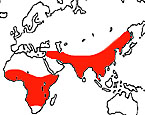|
Leopard
(Panthera pardus) #63-261 |
||||
|
|
Physical
characteristics and distribution
|
|
Leopards (Panthera pardus) are one of the four 'big cats' of the genus Panthera. They range in size from one to almost two metres long, and weigh between 30 and 70 kg. The Leopard is a sexually dimorphic species, with females being typically around two-thirds the size of males. Most Leopards are light tan or fawn with black spots, but their coat color is highly variable. The spots tend to be smaller on the head, and larger with pale centres on the body. The unique spotted pattern of the coats of Leopards helps to camouflage them in the lowland forests, mountains, grasslands, brush country and desert habitats which they occupy. Leopards are usually nocturnal, resting by day on the branch of a tree, in dense vegetation or among rocks. It may move 25 km in a night, and generally moves by a slow, silent walk, although it can briefly run at speeds of over 60 km/hr. It may leap over 6 meters horizontally and over 3 meters vertically. It climbs with great agility and can descend headfirst. Vision and hearing are acute, and the sense of small seems to be better developed than that of a tiger. Hunting is accomplished by stealthily approaching its prey by stalking. Larger animals are seized by the throat and killed by strangulation. Smaller prey may be dispatched by a bite to the back of the neck. Prey consists of medium-sized ungulates. But monkeys and baboons also are commonly taken. If necessary, the leopard can switch to prey such as rodents, rabbits, birds and arthropods. Food is often stored in trees for later use. Individuals keep to a restricted area, which they defend against others of the same sex. Territories are marked with urine. The range of a male may include that of one or more females. Leopards are normally a solitary species. There are a variety of communicative vocalizations, most commonly a coughing grunt and a rasping sound. Breeding occurs throughout the year in Africa and India. A female may give birth every l1-2 years. The estrous cycle is about 46 days, and heat lasts 6-7 days; gestation period is 90-105 days. Births occurs in a cave, crevice, hollow tree, or thicket. Litter size is one to six. Cubs weight 500-600 grams. Tyes open after 10 days, weaned at 3 months, and cubs separate from the mother at 18-24 months. Prior to the human-induced changes of the last few hundred years, Leopards were the most widely distributed of all felids other than the domestic cat: they were found through most of Africa (with the exception of the Sahara Desert), as well as parts of Asia Minor. The Leopard is doing surprisingly well for a large predator. It is estimated that there are as many as 500,000 Leopards worldwide. But like many other big cats, Leopards are increasingly under threat of habitat loss and are facing increased hunting pressure. Because of their stealthy habits and camouflage, they can go undetected even in close proximity to human settlements. Despite the Lleopard's abilities, it is no match for habitat destruction and poachers, and several subspecies are endangered, namely, the Amur, Anatolian, Barbary, North Chinese, and South Arabian Leopards. They are still found in Afghanistan, Algeria, Angola, Arabia, Armenia, Botswana, Burma, Cameroon, Central African Republic, Chad, China, Dem. Rep. Congo, Egypt, Ethiopia, Gabon, Guinea-Bissau, India, Indonesia (Java), Iran, Iraq, Kenya, Liberia, Laos, Malawi, Malaysia, Muritania, Morocco, Mozambique, Namibia, Nepal, Niger, Nigeria, North and South Korea, Pakistan, Republic of Congo, Russia, Saudia Arabia, Senegal, Sierra Leone, Somalia, South Africa, Sri Lanka, Sudan, Tanzania, Thailand, Tunisia, Turkey, Turkmenistan, Uganda, Vietnam, Zambia and Zimbabwe. |
|
Description
of the brain
|
|
Animal
source and preparation
|
|
All
specimens collected followed the same preparation
and histological procedure.
|
Other Related Resources (websites and publications)
List of Specimens | Explore Collections | Brain Sections | Brain Evolution | Brain Development | Brain Circuitry | Brain Functions | Location and Use | Related Web Sites | Contact Us | Search MSU Database | Personnel | Home



